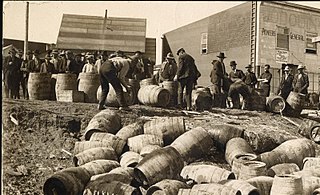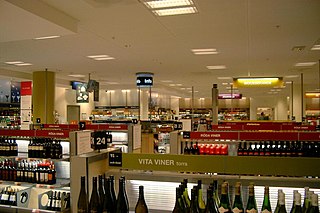
Prohibition is the act or practice of forbidding something by law; more particularly the term refers to the banning of the manufacture, storage, transportation, sale, possession, and consumption of alcoholic beverages. The word is also used to refer to a period of time during which such bans are enforced.

The Eighteenth Amendment of the United States Constitution established the prohibition of "intoxicating liquors" in the United States. The amendment was proposed by Congress on December 18, 1917, and was ratified by the requisite number of states on January 16, 1919. The Eighteenth Amendment was repealed by the Twenty-first Amendment on December 5, 1933.
Since the introduction of parliamentarism in Sweden, six national referendums have been held. Legal provisions for referendums were introduced in 1922, one year after the adoption of universal suffrage. The Constitution of Sweden provides for binding referendums, but all referendums held as of 2012 have been non-binding. The latest referendum, on adopting the euro, was held on 14 September 2003.

The Société des alcools du Québec is a provincial Crown corporation in Quebec responsible for the trade of alcoholic beverages within the province.
A local option is the ability of local political jurisdictions, typically counties or municipalities, to allow decisions on certain controversial issues based on popular vote within their borders. In practice, it usually relates to the issue of alcoholic beverage and marijuana sales.
A consultative and facultative referendum on continuing with prohibition was held in Norway on 18 October 1926. Partial prohibition had been effective since 1917, and following a 1919 referendum, spirits and dessert wine had also been banned.
The prohibition of alcohol in Canada arose in various stages, from local municipal bans in the late 19th century, to provincial bans in the early 20th century, and national prohibition from 1918 to 1920. The relatively large and powerful beer and alcohol manufacturing sector, and the huge working class that purchased their products, failed to convince any of the governments to reverse their stance on prohibition. Most provinces repealed their bans in the 1920s, though alcohol was illegal in Prince Edward Island from 1901 to 1948. By comparison the temperance act in Ontario ran from 1916 to 1927.

An alcohol monopoly is a government monopoly on manufacturing and/or retailing of some or all alcoholic beverages, such as beer, wine and spirits. It can be used as an alternative for total prohibition of alcohol. They exist in all Nordic countries except Denmark proper, and in all provinces and territories in Canada except Alberta. In the United States, there are some alcoholic beverage control states, where alcohol wholesale is controlled by a state government operation and retail sales are offered by either state or private retailers.
An Ontario prohibition plebiscite was held on January 1, 1894, in conjunction with municipal elections under the Prohibition Plebiscite Act, on the legality of alcoholic beverages and the implementation of prohibition. Though the plebiscite passed, the results were non-binding and prohibition would not occur in Ontario until 1916.
An Ontario prohibition referendum was held on December 4, 1902, under the Liquor Act, on the legality of alcoholic beverages and the implementation of prohibition in the province. Though the referendum passed, a majority of half of the voters in the 1898 election did not support the motion and prohibition was not introduced. Prohibition would not occur in Ontario until 1916.
An Ontario prohibition referendum was held on April 18, 1921 concerning a ban on the importation of alcoholic beverages into Ontario.

The U.S. state of Oregon has an extensive history of laws regulating the sale and consumption of alcoholic beverages, dating back to 1844. It has been an alcoholic beverage control state, with the Oregon Liquor Control Commission holding a monopoly over the sale of all distilled beverages, since Prohibition. Today, there are thriving industries producing beer, wine, and liquor in the state. Alcohol may be purchased between 7 a.m. and 2:30 a.m. As of 2007, consumption of spirits is on the rise, while beer consumption is holding steady. Also, 11% of beer sold in Oregon was brewed in-state, the highest figure in the United States.
In Iceland, Beer Day is celebrated every year on March 1, honoring the elimination of the 74-year prohibition of beer. Prohibition lasted from January 1, 1915 to March 1, 1989.
The 1923 Alberta prohibition plebiscite, held on November 5, 1923, was a province-wide plebiscite held in Alberta, Canada, to allow alcoholic beverages, triggered by an affirmative vote in the Legislative Assembly of Alberta, based on the presentation of a 56,000-name petition in accordance with the requirements of the Direct Legislation Act (1913), a citizens referendum Law or initiative law, in force at the time.
Following the end of Canada-wide war-time Prohibition, Canadian Liquor Plebiscites were held on October 25, 1920 in the provinces of Alberta, Manitoba, Nova Scotia and Saskatchewan under the Canada Temperance Act and the Dominion Elections Act.
Prohibition in Iceland went into effect in 1915 and lasted, to some extent, until 1 March 1989. The ban had originally prohibited all alcohol, but from 1922 legalized wine and in 1935 legalized all alcoholic beverages except beer with more than 2.25% alcohol content. As in many other states with prohibition, "illegal brewing and smuggling of alcoholic beverages were widespread during the ban."
Three referendums were held in Switzerland during 1908. The first two were held on 5 July on amending the federal trade law and on banning absinthe. Both were approved by a majority of voters and cantons. The third was held on 25 October on adding article 24bis to the constitution, concerning hydroelectricity and electricity. It was also approved by a majority of voters and cantons.
A four-part referendum on alcohol was held in the Faroe Islands on 6 November 1907. Voters were asked whether they approved of the trading and serving of beer, wine and spirits. All four proposals were rejected by voters. Following the referendum, prohibition was introduced in 1908 on all beverages with an alcohol content above 2%. An attempt in 1973 to overturn this ban was rejected in another referendum, but it was eventually lifted in 1992.





